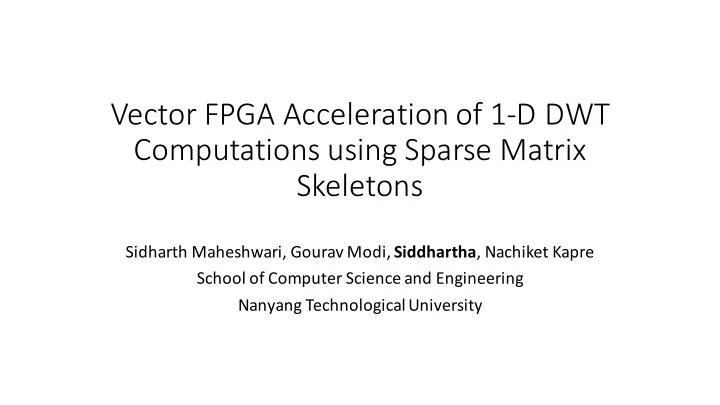

Vector FPGA Acceleration of 1-D DWT Computations using Sparse Matrix Skeletons Sidharth Maheshwari, Gourav Modi, Siddhartha , Nachiket Kapre School of Computer Science and Engineering Nanyang Technological University
Matrix-Form 1-D DWT • Formulation: * 𝐷 = 𝑈𝑁 % 𝑌 , where 𝑈𝑁 = ∏ 𝑈 ) () • TM matrix is highly sparse Ø Large number of multiply-by-zero operations Ø Large memory footprint consisting of zeroes • Goals: Ø SIMD-friendly operations on non-zero values only Ø Customized DMA routines for efficient bandwidth utilization
Matrix-Form 1-D DWT • Formulation: * 𝐷 = 𝑈𝑁 % 𝑌 , where 𝑈𝑁 = ∏ 𝑈 ) () • TM matrix is highly sparse Ø Large number of multiply-by-zero operations Ø Large memory footprint consisting of zeroes • Goals: Ø SIMD-friendly operations on non-zero values only Ø Customized DMA routines for efficient bandwidth utilization
Matrix-Form 1-D DWT • Formulation: * 𝐷 = 𝑈𝑁 % 𝑌 , where 𝑈𝑁 = ∏ 𝑈 ) () • TM matrix is highly sparse Ø Large number of multiply-by-zero operations Ø Large memory footprint consisting of zeroes • Goals: Ø SIMD-friendly operations on non-zero values only Ø Customized DMA routines for efficient bandwidth utilization
Sparse Matrix Skeleton 8 36 • Remove multiply-by-zero operations • Reduction in memory footprint of TM .
Modified Matrix-Form 1-D DWT N = 65536
VectorBlox MXP • Lanes: 16-32 • Scratchpad: 64-128 KB • DMA bandwidth: 4-32 B/cycle
Results - Speedup 60 55 50 45 40 Speedup Baseline CPU 35 Raspberry Pi 30 Zedboard 25 BeagleBone Black 20 15 10 5 0 MXP − DE2 MXP − DE4 MXP − Zed Board 𝑂 = 2 -. , 𝑀 = 6 𝑏𝑜𝑒 𝑙 = 3
Results - Speedup 60 55 50 45 40 Speedup Baseline CPU 35 Raspberry Pi 30 Zedboard 25 BeagleBone Black 20 15 10 5 0 MXP − DE2 MXP − DE4 MXP − Zed Board 𝑂 = 2 -. , 𝑀 = 6 𝑏𝑜𝑒 𝑙 = 3
Results - Speedup 60 55 50 45 40 Speedup Baseline CPU 35 Raspberry Pi 30 Zedboard 25 BeagleBone Black 20 15 10 5 0 MXP − DE2 MXP − DE4 MXP − Zed Board 𝑂 = 2 -. , 𝑀 = 6 𝑏𝑜𝑒 𝑙 = 3
Summary • We propose a Modified Matrix-Form scheme to unlock inherent parallelism in 1-D DWT • We exploit the sparsity pattern in TM to reduce complexity from O( 𝑜 8 ) to O( 𝑜 ) using : Skeletons to avoid wasteful multiply-by-zero operations Ø Rearrangement of input samples Ø • Speedups of 12-103x over state-of-the-art in-built signal library in Octave( dwt function)
Experimental Setup Matrix-form 1-D DWT Sparse Matrix Skeletons CPU CPU + MXP - Optimized OpenBLAS routines in - Customized DMA routines for data transfer between host and MXP Octave and C (compiled with –O3) - 16-32 vector lanes - Performance measured using PAPI v5.4.3 - 64-128KB scratchpad memory - Performance measured using MXP - 32b ARMv7 on Beaglebone Black, Timing API Zedboard, and ARMv6 on Raspberry Pi - Altera DE2/DE4 and Zedboard
Results - Throughput ● ARM (Beagl.) ARM (Zedb.) MXP − DE4 ● ARM (Rasp.) MXP − DE2 ● MXP − Zed 80 Energy (mJ) 60 40 ● ● 20 ● 0.1 1.0 Throughput (GOps/S) 𝑂 = 2 -. , 𝑀 = 6 𝑏𝑜𝑒 𝑙 = 3
CHALLENGES: • Large volume of data • Strict real-time processing constraints • High accuracy demands • Energy constraints, especially in embedded systems
Modified Matrix-Form 1-D DWT Rearrangement
Recommend
More recommend